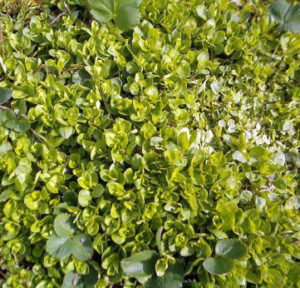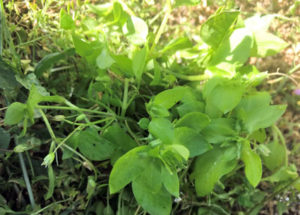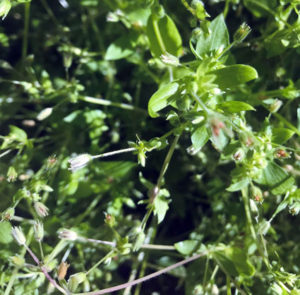Herbal Remedies from the Judean Hills
כוכבית – Common Chickweed – Stellaria Media
Printable Verison
Chickweed –The Sweet, Gentle, Powerful Star-shaped Healer
Chickweed is one of the sweetest, gentlest herbs I know. Although completely harmless, without a hint of bitterness, it is a powerful healer. It is another gift of G-d that grows wild and therefore doesn’t need tithing. There is no part of the world where you can’t find the delicate, reclining chickweed with small leaves and tiny white flowers with five, deeply cleft petals, which look like ten petals. It has become one of the commonest weeds in every part of the world. Although I love chickweed, it doesn’t seem to want to stay in its place and keep away from bothering my other plants. I’ve disentangled and weeded out my chickweed from the Swiss Chard several times in the last few months. It somehow finds its own quiet way to return. Meanwhile, I use my bucketful of chickweed in smoothies, dips, soups, and even pies, when I have the time. Chickweed is a creeping, mat-like plant. If left to grow uninhibited, it can form a dense carpet.

In less suitable places, it becomes spindly and tedious to collect. Look for the rich patches, where you can quickly fill a basket. Chickweed has a weak stem trailing on the ground with succulent egg-shaped smooth leaves placed in pairs and small white star-like flowers with narrow petals. The flowers that begin blooming in Nissan (March), continue all through the summer. They open about nine o’clock in the morning and are said to remain open for only twelve hours in bright weather. Rain prevents them from opening, and after a heavy shower, they become pendent instead of having their faces turned up towards the sun. In the course of a few days, they rise again. The seeds are contained in a little capsule fitted with teeth, which close up in wet weather, but open when ripe to allow the seeds to be shaken out by each movement of the plant in the breeze. The Latin name ‘Stellaire’ means ‘star,’ and so, it is also called ‘starweed’ due to chickweed’s star-shaped flowers. If you believe the macrobiotic theory that “you become what you eat,” – (you take on the energetic characteristics of the food you eat), we should all want to ingest more chickweed. Who wouldn’t want to become hardy (the seeds remain viable for up to 60 years), prolific (spreads by seed, root, node, and cutting), widespread (found world-wide), low maintenance, highly nutritious, a multi-dimensional healer, demure but beautiful, a superstar (it’s tiny white flowers form a 10 pointed star!)?
Nurture Your Relationships with Chickweed
Chickweed teaches us to balance care of self and others. Every night the leaves approach each other, folding their upper leaves over the tender buds of the new shoots, covering the terminating pair. This way each plant cares for itself by protecting the tip of its new shoot.
Simultaneously, chickweed grows most often in groups. If you happen across a patch of chickweed, you’ll notice from a distance that it appears to be closely clumped, creating a soft, billowy green carpet. As you come closer, you will see that each member of the patch has plenty of space to grow comfortably while still being in close contact with the rest of the group. Thus, chickweed supports individuality and space within the structure of a healthy, balanced group and environment, teaching us how to live and survive in balance with ourselves and with others. It is therefore not surprising that chickweed was used, in European folklore, to promote fidelity, attract love, and maintain relationships. It may be helpful for maintaining a good marriage to add a little bit to your own and your spouse’s food every day.
Chickweed is also a star that requires us to be uncompromising in our demand for quality.
From the fact that chickweed only grows in pH balanced, cultivated, cool and damp but not soaked soil, we can learn balance and discrimination. Chickweed is picky about its growing conditions, although those conditions can be found in unlikely places, such as on compost heaps, in sidewalk cracks, around fence posts, on or near manure piles, in old stone walls, as well as in well-cultivated gardens. We learn from chickweed to look beyond the surface, into the soil in which we want to grow our relationship for the life promoting qualities that will best support us. Without the qualities needed for healthy growth, chickweed advises us to move on.
Not only is chickweed delicious, nutritious and widespread, but it is one of the most versatile first-aid plants you’ll ever run across. It needs no fertilizer, nor pesticides to protect it from bugs, and plants itself besides. It is high in nutrients such as vitamins A, C, some B’s, calcium, phosphorus, potassium, zinc, and fatty acids – a natural emulsifier (or “fat dissolver”) that can lower cholesterol levels. Chinese herbal medicine regards it as sweet, moist and cool. Eat the whole plant together, leaves, stems, flowers, seedpods and all, raw or cooked. Since chickweed tends to intertwine with other weeds and fallen leaves, careful cleaning and culling is necessary after harvest to ensure no other plants are included.
Chickweed – A Skin Healer Par Excellence
Chickweed is one of the most well-known and highly prized medicinal weeds, especially as an anti-itch cream. It makes an excellent poultice and salve, useful for all manner of skin ailments such as eczema, itching dermatitis, hives and even cancerous sores. The water in which chickweed was boiled may also be used to bathe the affected part.
Inflammation:Chickweed provides antibiotic agents, promotes healing and soothes irritated tissues. Due to its high saponin content, the fresh herb may be employed as a poultice for inflammation, ulcers and to dissolve skin tumors.
Swellings: Make a decoction from a handful or two of fresh chickweed. Bathe the surface every
½ hour and apply chickweed ointment (the pain and swelling will be gone in a few hours). For swollen testicles, burning and itching genitals, bathe the area in a strong decoction of chickweed and apply chickweed ointment.
Hemorrhoids: Bathe the area 2-3 times daily in chickweed decoction, infusion, or diluted tincture (as warm as possible), then apply chickweed ointment.
Poison Ivy, Oak or Stinging Nettle: Use chickweed ointment to relieve the itching and to aid in neutralizing poisons.
Internal Medicinal Properties of Chickweed
Besides being a wonderful skin healer and food plant, chickweed is well known in herb circles for its versatile healing charms. It is a very safe, gentle, mild herb that can be used on newborn babies.
Respiratory: Chickweed is beneficial for reducing mucus build-up and may be used to treat a variety of respiratory problems, including bronchitis, chronic coughing, colds/flu, sore throat, and hoarseness.
Metabolism: Chickweed provides the body with nutrients that are necessary for balancing metabolicfunctions. It also contains fiber, which helps improve digestion and relieve constipation.
Weight loss: Chickweed water is an old wives’ remedy for obesity. It is used in herbal weight-loss formulas because of its high amount of saponins, which dissolves fat cells and lowers cholesterol. Chickweed also supplies vast amounts of nutrients to compensate for reduced calories when dieting.
Rheumatism: Chickweed is used internally as a cleansing diuretic and tonic for rheumatic pains and for softening and soothing inflamed areas, such as gastric mucous membranes.
Scurvy: Sailors used chickweed vinegar to prevent scurvy when fresh citrus was unavailable.
Chickweed for Birds
Chickweed is so called because chickens and small birds are fond of it. The custom of giving chickweed to birds is ancient. Gerard tells us: ‘Little birds in cadges (especially Linnets) are refreshed with the lesser chickweed when they loath their meat whereupon it was called of some “Passerina.” Both wild and caged birds eat chickweed seeds as well as the young tops and leaves. Pigs like it; rabbits, cows and horses will eat it; sheep are indifferent to it, but goats refuse to touch it.
Culinary Uses
Chickweed is very mild-tasting and tender in texture, making it a super salad green. It is excellent as a base for a wild salad, in place of lettuce. I like to mix it with grated carrots and then add smaller amounts of stronger tasting greens or other salad items like olives, nuts, avocados, or whatever. The lush end-growth and larger leaves are good in salads, but when blending into smoothies, dips or dressings I toss in the stems and all. I do occasionally cook it if I have large amounts but it really shines as a raw, fresh, living green. The young leaves when cooked can hardly be distinguished from spring spinach, and are equally wholesome. Thus, it received its nickname ‘poor man’s spinach. Chickweed is a great pizza topping. Cook as you would spinach. Use in soups, stews, omelets, dips, meat pies, and fried rice. It retains its bright green color when cooked, making every dish more attractive. It is also a great choice of green in rice or bean salads. Chickweed also makes a sweet tea and can be drunk anytime, hot or cold. Add a little honey for an even more pleasant beverage.
Hands On:
Harvest chickweed before it flowers for the tenderest greens. Snip off the blooms from the stems a few inches above ground to encourage more growth. Collect the herb between January and May, when it is in the best condition. Dry or freeze it to use in soups and as a condiment. Chickweed freezes beautifully. I keep bags full in the freezer and grab a handful to throw into just about every dish. It is a great parsley substitute. One teaspoon dried herb = 4 teaspoons fresh or frozen.
Chickweed Ointment
I want to empower all of you to make your own ointment with this simple recipe. Keep it in the refrigerator and use it for every little cut, nick, insect bite, itchy skin, and pimple.
1 ¼ cup olive oil
Approximately 1 cup of fresh chickweed
½ cup bees wax
1. Bring the olive oil to low heat in a small stainless steel pot. Do NOT boil.
2. Add as much chickweed as you can push below the surface.
3. Let this steep for about an hour over a low, low fire to extract all the juice. Strain.
4. Add the bees wax.
5. Pour off into little ointment jars. Cool and store in a dark place.
Chickweed and Tempeh Quiche
To this basic quiche recipe, you can truly add any succulent green, any meat that cooks quickly, leftovers, whatever you want. The secret to the taste of this one is the beer. Everyone in our family would literally walk a mile for a slice. As simple as it is to make, this is some fine-tasting cuisine. Be sure and try it.
1 homemade pie crust of your choice
1 tbsp. cooking oil or butter
1 large onion, diced
1 lb. tempeh or tofu
1 cup chopped chickweed (any greens will do, but chickweed adds a sweet corn flavor)
½ bottle of beer
Salt, pepper and seasonings to taste
5 eggs, scrambled, a 6th egg handy just in case you need it
1. Wilt onion in oil until translucent, then add tempeh and sauté till they turn half-pink.
2. Add chickweed and stir around for about 1 minute.
3. Add the beer and seasonings and stir well. Turn off the heat.
4. Add 5 lightly beaten eggs, stir well, taste for seasoning.
5. Add a little more beer and an extra egg as needed to fill out the pie shell.
6. Turn into an unbaked pie shell. Place on cookie sheet and bake 35-45 minutes at 375°.
7. During the last 5 minutes, baste top of pie crust with egg. It makes the crust come out a shiny gold.
Pie Crust
1 cup all-purpose flour
1/2 stick real butter (softened)
1 tsp salt
½ cup cold water
1. Place butter in big bowl and leave out to soften.
2. Add flour and salt, and cut the dry ingredients into the butter till it’s all flaky.
3. Make a hole in the middle, add about half the cold water, and stir to moisten with a wooden spoon.
4. Keep adding water, until the dough forms a non-sticky ball. Handle as little as possible to get the flakiest crust.
5. Throw some dried, powdered chickweed or other herbs right into the crust for a gourmet touch.
6. Press piecrust into baking pan, flute the edges.
Creamy Chickweed Dressing This recipe is truly yummy (and healthy)!
½ cup olive oil
1 tablespoon lemon juice (or vinegar)
1 tsp honey
2 cups fresh chickweed greens
¼ tsp salt
1 clove of garlic
dash of pepper
½ cup yogurt (may substitute techina or coconut cream mixed with water for parve dressing
1. In blender or food processor, blend all ingredients but the yogurt thoroughly.
2. Add yogurt (diluted techina or coconut cream), and blend gently until smooth.
https://www.berotbatayin.org
http://www.voices-magazine.com/#




